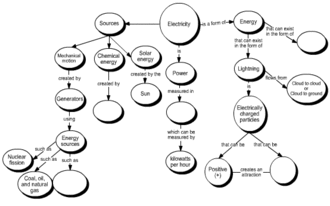
Back خريطة المفهوم Arabic Mapa conceptual Catalan Pojmová mapa Czech Concept-Map German Εννοιολογικός χάρτης Greek Koncepta mapo Esperanto Mapa conceptual Spanish Mõistekaart Estonian Kontzeptu mapa Basque نمودار مفهومی Persian

 |
| Information mapping |
|---|
| Topics and fields |
| Node–link approaches |
|
| See also |
A concept map or conceptual diagram is a diagram that depicts suggested relationships between concepts.[1] Concept maps may be used by instructional designers, engineers, technical writers, and others to organize and structure knowledge.
A concept map typically represents ideas and information as boxes or circles, which it connects with labeled arrows, often in a downward-branching hierarchical structure but also in free-form maps.[2][3] The relationship between concepts can be articulated in linking phrases such as "causes", "requires", "such as" or "contributes to".[4]
The technique for visualizing these relationships among different concepts is called concept mapping. Concept maps have been used to define the ontology of computer systems, for example with the object-role modeling or Unified Modeling Language formalism.
- ^ Peter J. Hager, Nancy C. Corbin. Designing & Delivering: Scientific, Technical, and Managerial Presentations, 1997, p. 163.
- ^ Cite error: The named reference
Lanzingwas invoked but never defined (see the help page). - ^ Cite error: The named reference
RomanceVitale1999was invoked but never defined (see the help page). - ^ Novak, Joseph D.; Cañas, Alberto J. (2008). The theory underlying concept maps and how to construct and use them (Technical report). Pensacola, FL: Institute for Human and Machine Cognition. 2006-01 Rev 2008-01. Retrieved 24 November 2008.
© MMXXIII Rich X Search. We shall prevail. All rights reserved. Rich X Search